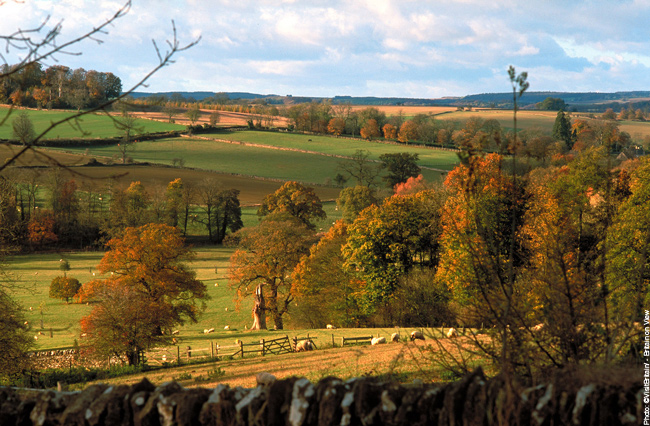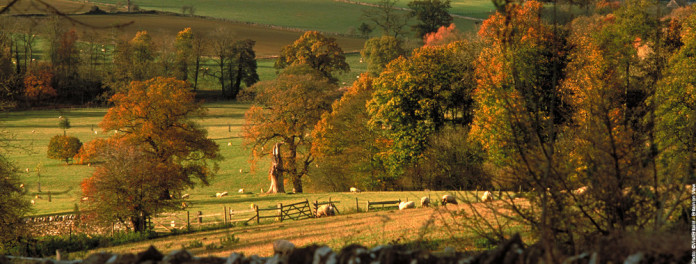The Cotswolds, a glorious tapestry woven from parts of Gloucestershire, Oxfordshire, Warwickshire and Wiltshire, is one of the most popular parts of Britain to explore. Read our insider’s guide to find its hidden treasures

The Cotswolds, an area of gently rolling hills, lush countryside and that ubiquitous honey-coloured stone bathing everything with a unique glow, is unsurprisingly one of the most visited, photographed and loved parts of the country. But away from the obvious and ample charms of tourist honey pots like Broadway and Stow-on-the-Wold lies an equally lovely but hidden side to the area, with dreamy, timeless hamlets and misty water meadows, and the chance to make the Cotswolds feel like your own private discovery.
Take the stunning village of Naunton, for example. Beyond the obvious beauty of its picture-perfect Cotswold cottages and village green with the crystal-clear Windrush river meandering lazily by, Naunton has several interesting sights to see. The 17th-century dovecote on the banks of the river has over 1,000 nesting holes, owned and recently restored by the villagers themselves by way of the Naunton Village Trust. Or the beautiful and rather grand vicarage, which from 1860 to 1897 was home to the Reverend Edward Arthur Litton, who sometimes played host there to his close friend Charles Dodgson. Dodgson, of course, is better known these days as Lewis Carroll and the story goes that Litton’s daughter provided Carroll’s inspiration for Alice and her subsequent adventures. Like many of the villages in the area, Naunton also has its own church, Norman in origin, boasting two unique sun dials, worth looking out for on its tower.
Naunton is far from the only Cotswold village that benefits from the gentle flow of a river and in fact the many waterways that criss cross the area are one of its defining features. The Windrush is best known perhaps, bubbling as it does through the picturesque town of Bourton-on-the- Water, but just a little way from here it is possible to enjoy the quieter delights of the Little Eye stream and Old Mill Museum in Lower Slaughter, where you might also want to try an award-winning organic ice cream, made on the premises. Despite its rather grisly sound, Lower Slaughter’s name derives not from its setting as the scene of any great massacre, but from an Anglo-Saxon word meaning muddy or watery place. At Minster Lovell, the Windrush puts in an appearance again, snaking past the romantic ruins of the famously-haunted 15th-century Minster Lovell Hall, one-time host to Richard III. Less well known, but equally peaceful and picturesque is the limestone stream of the Coln, running past the ancient weavers’ residences of Arlington Row in Bibury, and the ivy-clad cottages of Coln St Aldwyns. A river-valley walk between the two will allow you to soak up the sights here, and don’t be surprised if Bibury in particular seems strangely familiar. It has provided the backdrop for Hollywood blockbusters such as Stardust, starring Robert De Niro, in its time.
Far off the beaten track, along a tributary of the Coln, Chedworth and its surroundings are a fascinating, if often overlooked, part of the Cotswolds. The village itself is pretty, however, the real attraction here is the National Trust-owned Chedworth Roman Villa, tucked away in an impossibly picturesque valley. Discovered in 1864, it is one of the country’s largest Roman villas and offers the chance to see Roman mosaics and bath houses, as well as the spring that feeds the villa, claimed as a shrine by both Paganism and Christianity at various points. One of the most wonderful things about the Cotswolds is the layers of history that can be explored in the area, and Chedworth is far from the only place to see the relics of Roman Britain.
Cirencester’s amphitheatre and Lydney Hillfort and Temple are also well worth a visit, to not only see Roman influence in action, but also take in the significance of the Bronze, Iron and Neolithic age cultures that came before.
Belas Knap is a particularly remote example of the latter, and also provides an excuse for a rather lovely walk. It’s situated between Winchcombe and Cheltenham, high on Cleeve Hill, so a visit to this atmospheric burial chamber provides spectacular views (Belas Knap literally translates as ‘Beautiful Hill’) as well as a chance to inspect the tombs, which upon their first excavation back in 1863 were found to contain the skeletons of five children. And, if the walking makes you hungry, you could always head into Winchcombe afterwards for lunch at timbered, AA two-rosette awarded Wesley House, or Michelin-starred 5 North Street – Sudeley Castle is just around the corner, too.
If Broadway must take its place with Stow-on-the-Wold and Bourton as one of the Cotswolds least well-kept secrets, a short walk away from it will take you into far less-travelled territory. Snowshill village stands on the escarpment above the town, and is home to perhaps one of the strangest manor houses in the area. From the outside the Elizabethan Snowshill Manor is as beautiful as one would expect, with extensive grounds, but it owes much of its current character to a relatively recent owner.
In 1919, it was brought by an architect, one Charles Paget Wade, who proved himself an eccentric in the grandest of English traditions. The gardens were redesigned as a series of quirky outdoor rooms, and the house itself was filled with all manor of Wade’s collections. These collections remain today and include clocks, bicycles, musical instruments and armour in a truly eclectic selection. It is possible to follow in the footsteps of Virginia Woolf, Graham Greene and J B Priestley, all of whom the house can claim as visitors, since the property is currently National Trust-owned.
A more traditional, but utterly breathtaking manor house can be found in the exquisite village of Stanway, a few miles north of Winchcombe. Stanway itself is a cluster of gorgeous and perfectly-kept cottages, with the house a jewel at its centre. As you enter the village from the main road you pass the gate house on your right, which is an aesthetic delight in its own right, with ornate decoration of roses and diamonds. The manor house is Jacobean in style, with mullion windows and gables, and constructed from the evocatively named ‘Guiting Yellow’ variety of Cotswold stone. It stands in stunning parkland including 18th-century water gardens that have slowly been restored to their original glory, with a tranquil, sheet-like ‘canal’ and splashing, musical cascades. The most recent addition to all of this grandeur is perhaps the most show-stopping. Stanway now hosts the tallest gravity fountain in the world, springing up from the canal with exuberant grace.
Interestingly enough, Stanway also provides the area with a second literary link to a famous children’s author. JM Barrie, who famously wrote Peter Pan, was a frequent guest at the house after the First World War. A rather charming story suggests that, while lying in bed one day, he saw a reflection of the church weathercock moving in the wind on the ceiling of his room, and thus the idea for Tinkerbell – the famous fairy – was born. Barrie’s love of cricket has been well documented (his famous if decidedly amateur team the Allahakbarries played matches in nearby Broadway) and he gifted the village with what must be the most picturesque cricket pavillion in the country. A timber-and-thatch structure, supported by mushroom-shaped stones, it is a fairytale-like building for this most fairytale like of Cotswold villages.
Of course, even in the best-known Cotswolds locations, delightful secrets lurk close by. A short walk from Stow-on- the-Wold, for example, will take you into the unspoilt environs of Maugersbury. And looming over the Regency town of Cheltenham are the delightful nooks and hollows of Cleeve Hill. Even in Cheltenham itself, with its wealth of gorgeous architecture, the pretty maze-like Suffolks area with its tiny cafes, specialist shops and continental feel is often missed by the casual tourist.
The unifying theme, wherever you go in the Cotswolds, is its beauty. And for a landscape that yields up its treasures so easily, it’s exciting to think that there are still more to discover.
Discover our Editor’s favourite places to visit in The Cotswolds!
Learn more about our Kings and Queens, castles and cathedrals, countryside and coastline in every issue of BRITAIN magazine!






 © 2024
© 2024